![]()
![]()
![]()
Use LEFT and RIGHT arrow keys to navigate between flashcards;
Use UP and DOWN arrow keys to flip the card;
H to show hint;
A reads text to speech;
18 Cards in this Set
- Front
- Back
|
a. Name the 5 special senses b. Give 3 distinct features of the special senses |
a. Taste, hearing, smell, balance, sight b. - all located in the head - have specialised sensory cells - innervated by cranial nerves |
|
|
- TASTE a. Sensory cells b. Nerves c. Brain processing |
a. Gustatory cells (+ supportive cells in the taste buds) b. - Facial (VII) - Vagus (X) - Glossopharyngeal (IX) c. Gustatory Cortex |
|
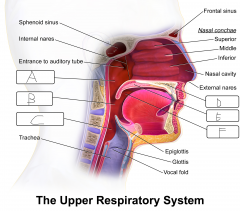
|
a. Nasopharynx b. Oropharynx c. Laryngopharynx d. Hard Palate e. Soft Palate f. Oral Cavity |
|
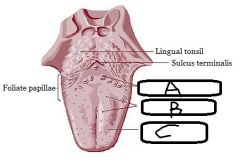
|
a. Vallate Papillae b. Fungiform Papillae c. Filiform Papillae |
|
|
a. where are taste buds mainly found? b. what kind of cells are taste buds made up of? c. Which nerve has receptors in the posterior 1/3 of the tongue? d. Which nerve has receptors in the anterior 2/3 of the tongue? e. Where does the Vagus Nerve (X) have taste receptors? |
a. Top of Fungiform Papillae b. - Basal cells (stem cells) - Gustatory cells c. Glossopharyngeal Nerve d. Facial Nerve e. Epiglottis and Lower Pharynx |
|
|
a. Smell is also called _____ b. What and where is the organ for smell? c. Sensory cells? d. Nerve? |
a. Olfactory b. - Olfactory Epithelium - In root of Nasal Cavity c. Olfactory cells d. Olfactory Nerve (I) |
|
|
- Hearing a. Sensory cells? b. Nerve? c. Brain processing? |
a. Hair cells (in Cochlea) b. - Auditory or - Vestibulocochlear (VIII) c. Auditory Cortex (Temporal Lobe) |
|
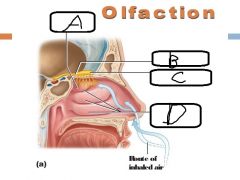
|
a. Olfactory Epithelium b. Olfactory Tract c. Olfactory Bulb d. Nasal Cavity |
|
|
- Balance a. Sensory Cells? b. Nerve? c. Brain processing? |
a. Hair cells (in Cochlea) b. - Auditory (VIII) c. Cerebellum |
|
|
Which senses does the Auditory (Vestibulocochlear) nerve serve? |
- Hearing - Balance |
|
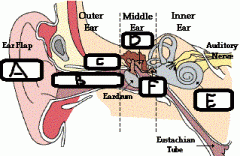
|
a. Pinna b. Auditory Canal c. Hammer d. Anvil e. Cochlear f. Stirrup |
|
|
- Sight a. Sensory cells? b. Nerves? c. Brain Processing? |
a. Rods and Cones in Retina b. - Optic (II) c. Visual Cortex in Occipital Lobe |
|
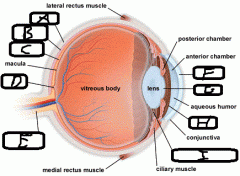
|
a. Sclera b. Choroid c. Retina d. Fovea e. Optic Nerve f. Cornea g. Pupil h. Iris i. Suspensory Ligament |
|
|
- The layers of the eye arecontinuous with the __(a)__ - Dura mater = __(b)__ - Arachnoid and Pia mater = __(c)__ - Cortex = __(d)__ - The eye is a part of the brain, __(e)__ contains brain cells |
a. Brain Meninges b. Sclera c. Choroid d. Retina e. Retina |
|
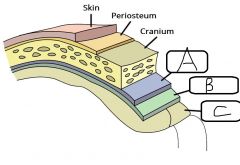
|
a. Dura Mater b. Arachnoid mater c. Pia Matwr |
|
|
Name the nerves involved in eye movement |
- Oculomotor (III) - Trochlear (IV) - Abducens (VI) |
|
|
a. Name the nerve involved in tongue movement b. What does the Trigeminal nerve do? (+ number) c. What does the Spinal Accessory nerve do? (+ number) |
a. Hypoglossal (XII) b. Facial Sensation + Massification (V) c. Head turning (XI) |
|
|
Name + number the 12 cranial nerves |
I Olfactory II Optic III Oculomotor IV Trochlear V Trigeminal VI Abducens VII Facial VIII Auditory IX Glossopharyngeal X Vagus XI Spinal Accessory XII Hypoglossal |

